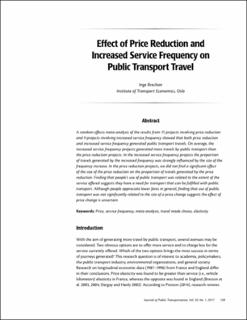| dc.contributor.author | Brechan, Inge | |
| dc.date.accessioned | 2020-05-08T13:24:13Z | |
| dc.date.available | 2020-05-08T13:24:13Z | |
| dc.date.created | 2017-02-21T22:32:22Z | |
| dc.date.issued | 2017 | |
| dc.identifier.citation | Journal of Public Transportation. 2017, 20 (1), 139-156. | en_US |
| dc.identifier.issn | 1077-291X | |
| dc.identifier.uri | https://hdl.handle.net/11250/2653742 | |
| dc.description | The Journal of Public Transportation is an open access journal which means that all content is freely available without charge to the user or his/her institution. Users are allowed to read, download, copy, distribute, print, search, or link to the full texts of the articles in this journal without asking prior permission from the publisher or the author for non-commercial purposes. Nonetheless, reproduction, posting, transmission or other distribution or use of the article or any material therein requires credit to the original publication source with a link to both the article and the license. | en_US |
| dc.description.abstract | A random effects meta-analysis of the results from 15 projects involving price reduction and 9 projects involving increased service frequency showed that both price reduction and increased service frequency generated public transport travels. On average, the increased service frequency projects generated more travels by public transport than the price reduction projects. In the increased service frequency projects the proportion of travels generated by the increased frequency was strongly influenced by the size of the frequency increase. In the price reduction projects, we did not find a significant effect of the size of the price reduction on the proportion of travels generated by the price reduction. Finding that people’s use of public transport was related to the extent of the service offered suggests they have a need for transport that can be fulfilled with public transport. Although people appreciate lower fares in general, finding that use of public transport was not significantly related to the size of a price change suggests the effect of price change is uncertain. | en_US |
| dc.language.iso | eng | en_US |
| dc.rights | Navngivelse-Ikkekommersiell 4.0 Internasjonal | * |
| dc.rights.uri | http://creativecommons.org/licenses/by-nc/4.0/deed.no | * |
| dc.subject | price | en_US |
| dc.subject | service frequency | en_US |
| dc.subject | meta-analysis | en_US |
| dc.subject | travel mode choice | en_US |
| dc.subject | elasticity | en_US |
| dc.title | Effect of Price Reduction and Increased Service Frequency on Public Transport Travela | en_US |
| dc.type | Peer reviewed | en_US |
| dc.type | Journal article | en_US |
| dc.description.version | publishedVersion | en_US |
| dc.source.pagenumber | 139-156 | en_US |
| dc.source.volume | 20 | en_US |
| dc.source.journal | Journal of Public Transportation | en_US |
| dc.source.issue | 1 | en_US |
| dc.identifier.doi | 10.5038/2375-0901.20.1.8 | |
| dc.identifier.cristin | 1452943 | |
| cristin.unitcode | 209,6,2,0 | |
| cristin.unitname | Institutt for psykologi | |
| cristin.ispublished | true | |
| cristin.fulltext | original | |
| cristin.qualitycode | 1 | |

